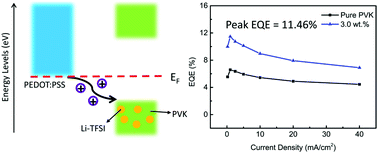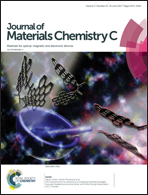High-efficiency quantum dot light-emitting diodes employing lithium salt doped poly(9-vinlycarbazole) as a hole-transporting layer†
Abstract
For the purpose of fabricating solution-processed quantum-dot light-emitting diodes (QLEDs) with high performance, the efficient hole–electron recombination at low current density is particularly pivotal. Herein, to enhance the charge balance of the QLED device, we employed lithium bis(trifluoromethylsulfonyl)imide (Li-TFSI) as a p-type dopant into the hole-transporting material (HTM) of poly(9-vinlycarbazole) (PVK). In the experiment, the increased conductivity and the enhanced charge mobility of the Li-TFSI-doped PVK layer were confirmed by the J–V curves of the hole-only devices and conductive atomic force microscopy (c-AFM). Furthermore, on combining ultraviolet photoelectron spectroscopy (UPS) and the absorption spectra, it was found that the highest occupied molecular orbital (HOMO) of the Li-TFSI-doped PVK layers gradually shifted closer to the Fermi level upon increasing the doping ratios from 0 to 4.5 wt%. Therefore, the hole-injecting barrier decreases from 1.17 eV to 0.64 eV. As a result, the maximum current efficiency and the highest external quantum efficiency (EQE) of our fabricated QLED devices can reach as high as 15.5 cd A−1 and 11.46%, respectively. It was demonstrated that the p-type dopant Li-TFSI in the HTM can contribute to the fabrication of high-performance solution-processed light-emitting diodes.



 Please wait while we load your content...
Please wait while we load your content...